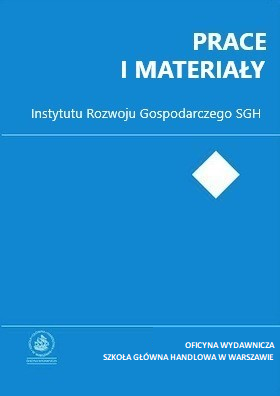To be (accounted for) or not to be: Factors influencing probability of non-response in economic tendency surveys
Main Article Content
Abstract
Non-response constitutes the major challenge for empirical studies based on survey data as it introduces the element of self-selection and damages representativeness of surveys. So far, formal analyses of causes of survey non-response have not resulted in supplying satisfactory remedial measures. The aim of this paper is to establish key factors affecting probability that a firm will respond to an economic tendency survey, and to propose methods to increase response rates. Empirical results lead to conclusion that information collected in the RIED (Research Institute for Economic Development of the Warsaw School of Economics) ąuestionnaires does not allow to identify factors that influence non-response. The only statistically significant finding is a tendency of petroleum, chemical, pharmaceutical, rubber and plastic producers to be more responsive than other companies. Any additional factors that determine probability of responding to the RIED economic tendency survey remain unknown. Short-term solutions to the non-response problem include establishing direct contact with non-respondents and use of incentives; in the long-run, reąuests for additional information from the respondents may facilitate further studies on causes of survey non-response.(original abstract)
Article Details
References
Bethlehem, J. (2009). Applied Survey Methods: A Statistical Perspective. New Jersey: John Wiley & Sons.
Białowolski, P. (2016). The influence of negative response style on survey-based household inflation expectations. Quality & Quantity. International Journal of Methodology, 50: 509-528.
Curtin, R., Presser, S., Singer, E. (2005). Changes in telephone survey nonresponse over the past quarter century. The Public Opinion Quarterly. 69: 87-98.
Groves, R. M. (1989). Survey Errors and Survey Costs. New York: John Wiley & Sons.
Groves, R. M. (2006). Nonresponse rates and nonresponse bias in household surveys. The Public Opinion Quarterly, 70: 646-675.
GUS (2008). Zmiany strukturalne grup podmiotów gospodarki narodowej w 2007 r. Warszawa: GUS.
Kowalczyk, B. (2010). On selected issues of non-response in the case of business tendency surveys. Acta Universitatis Lodziensis. Folia Economica, 235: 263-271.
Rassmusen, K., Thimm, H. (2009). Fact-based understanding of business survey non-response. The Electronic Journal of Business Research Methods, 7(1): 83-92.
RIED (2017). Koniunktura w przemyśle. 344.
Särndal, C., Swensson, B., Wretman, J. (1992). Model Assisted Survey Sampling. New York: Springer-Verlag.
Schwarz, G. (2013). Response Rates in European Business Tendency Surveys. Vienna: Austrian Institute of Economic Research (WIFO).
Thompson, K., Oliver, B. (2012). Response rates in business surveys: Going beyond the usual performance measure. Journal of Official Statistics, 28(2): 221-237.
Toepoel, V., Schonlau, M. (2017). Dealing with nonresponse: Strategies to increase participation and methods for postsurvey adjustments. Mathematical Population Studies, 24(2): 79-83.
Tomczyk, E., Kowalczyk, B. (2010). Influence of non-response in business tendency surveys on properties of expectations. Statistic in Transition New Series, 11: 403-422.
